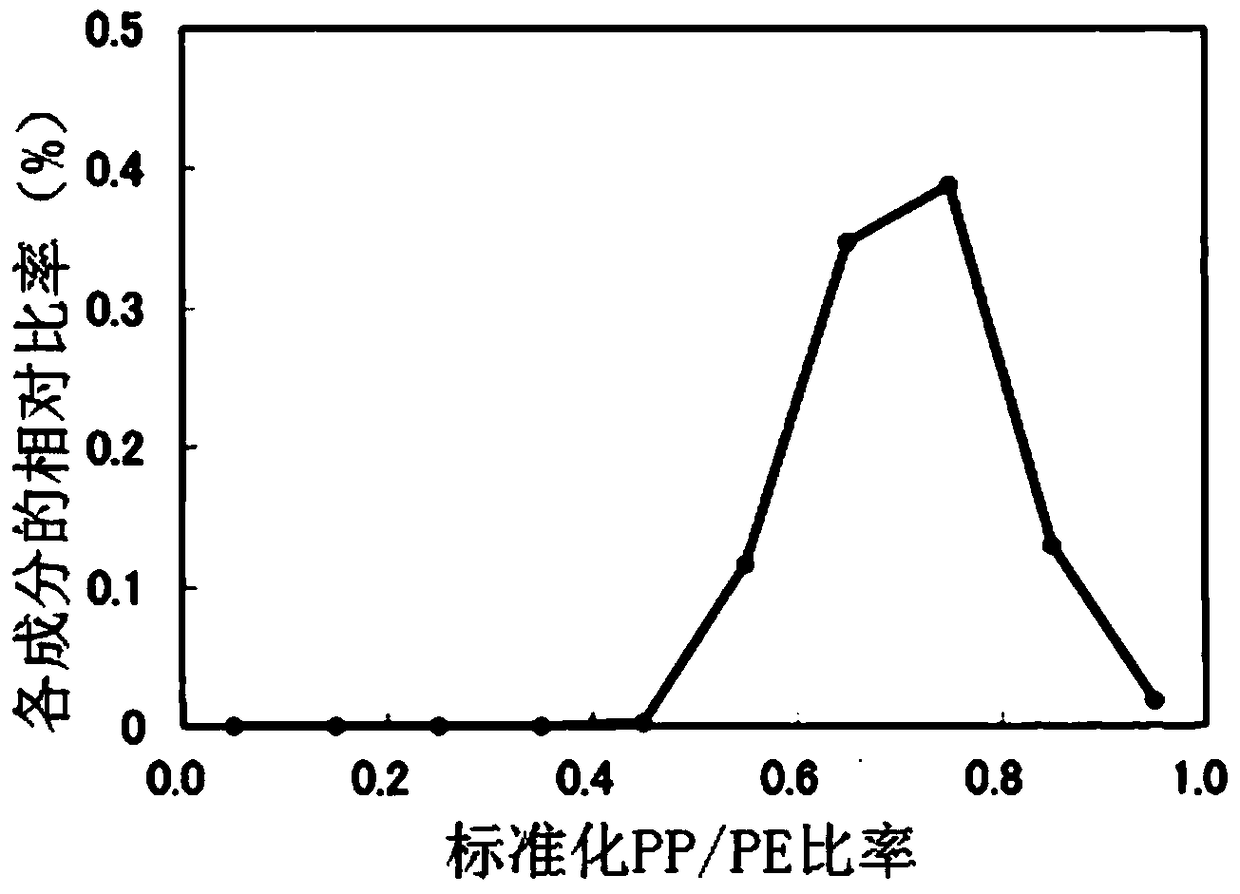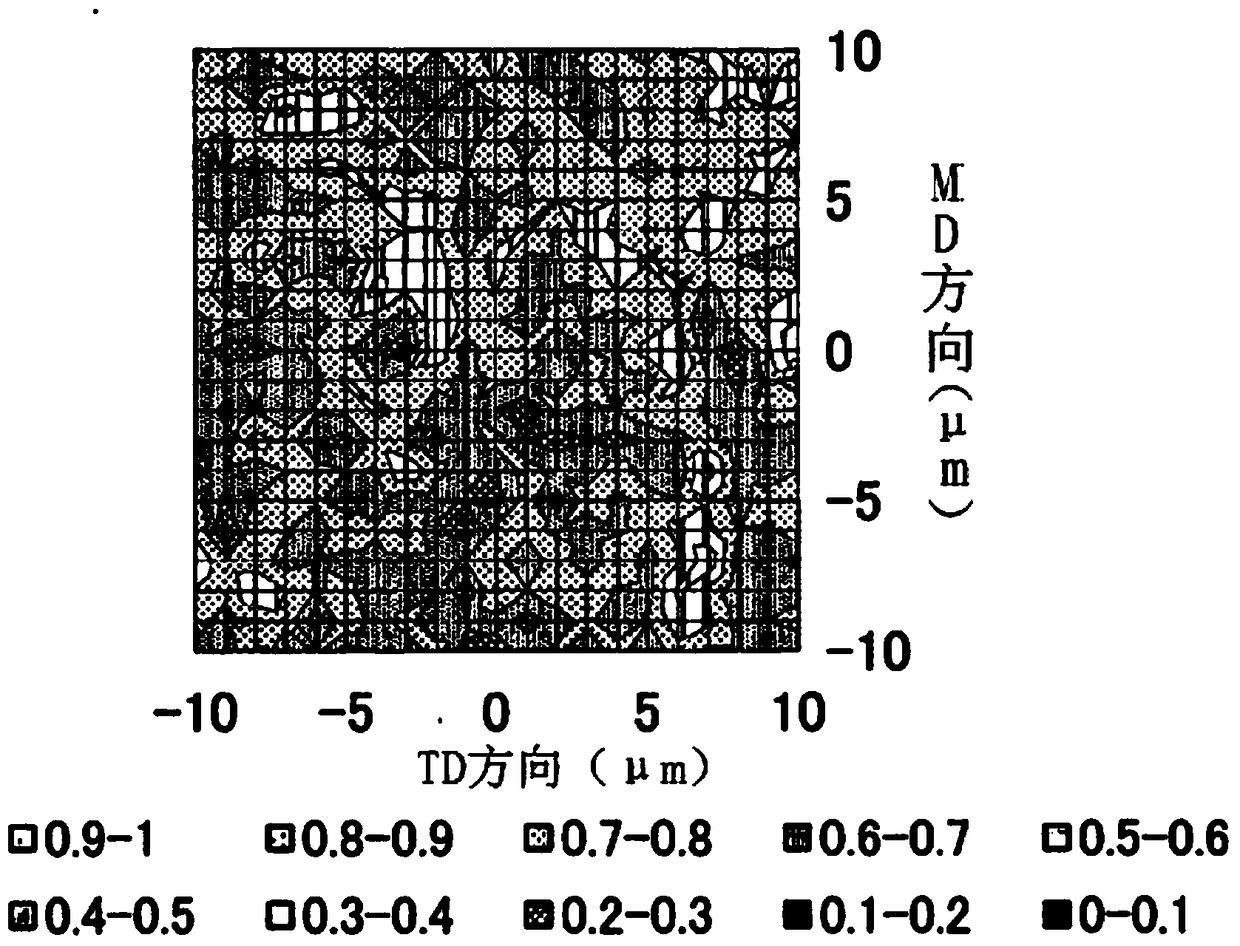Polyolefin microporous membrane and its manufacturing method
A microporous membrane, polyolefin technology, applied in chemical instruments and methods, structural parts, battery pack parts, etc., can solve the problem of inability to obtain the shutdown temperature, and achieve excellent electrolyte injection and shutdown characteristics. Excellent balance of air permeability and strength, excellent balance of air permeability and strength
- Summary
- Abstract
- Description
- Claims
- Application Information
AI Technical Summary
Problems solved by technology
Method used
Image
Examples
Embodiment 1
[0207] (1) Preparation of the first polyolefin solution
[0208] Prepare the first polyolefin composition by dry blending, relative to the total weight of the first polyolefin composition, comprising (a) Mw of 2.0×10 6 HDPE (Mw / Mn: 8, melting point: 136°C) 20% by weight, (b) Mw is 2.5×10 5 HDPE (Mw / Mn: 8.6, terminal vinyl group concentration of 0.1 per 10000 carbon atoms, melting point: 134°C) 57% by weight, (c) Mw is 1.8×10 4 HDPE (Mw / Mn: 2.6, melting point: 123°C) 20% by weight, and (d) Mw is 9.7×10 4Polypropylene (Mw / Mn: 2.6, melting point: 155°C) 3% by weight. With respect to every 100 parts by weight of the first polyolefin composition, dry blend 0.2 parts by weight of tetrakis [methylene-3-(3,5-di-tert-butyl-4-hydroxyphenyl)-propionate] methane as anti- An oxidizing agent is used to formulate the first polyolefin resin.
[0209] 25 parts by weight of the first polyolefin resin was supplied to the intensive kneading twin-screw extruder, and 75 parts by weight of liqui...
Embodiment 2
[0213] (1) Preparation of the first polyolefin solution
[0214] Prepare the first polyolefin composition by dry blending, relative to the total weight of the first polyolefin composition, comprising (a) Mw of 2.0×10 6 HDPE (Mw / Mn: 8, melting point: 136°C) 20% by weight, (b) Mw is 2.5×10 5 HDPE (Mw / Mn: 8.6, terminal vinyl group concentration of 0.1 per 10,000 carbon atoms, melting point: 134°C) 52% by weight, (c) Mw is 2.4×10 4 HDPE (Mw / Mn: 3.0, melting point: 123°C) 25% by weight, and (d) Mw is 9.7×10 4 Polypropylene (Mw / Mn: 2.6, melting point: 155°C) 3% by weight. With respect to every 100 parts by weight of the first polyolefin composition, dry blend 0.2 parts by weight of tetrakis [methylene-3-(3,5-di-tert-butyl-4-hydroxyphenyl)-propionate] methane as anti- An oxidizing agent is used to formulate the first polyolefin resin.
[0215] 25 parts by weight of the first polyolefin resin was supplied to the intensive kneading twin-screw extruder, and 75 parts by weight of liq...
Embodiment 2~ Embodiment 10 and comparative example 1~ comparative example 8
[0221] According to the raw materials and conditions shown in Table 1 and Table 2, Comparative Example 1 followed Example 1, and Examples 2-10 and Comparative Examples 2-8 followed the method of Example 2 to produce polyolefin microporous membranes in the same manner. In addition, "-" in Table 1 and Table 2 indicates that UHMwPE or HDPE2 in the table is not included.
[0222] [Table 1]
[0223]
[0224] [Table 2]
[0225]
PUM
| Property | Measurement | Unit |
|---|---|---|
| melting point | aaaaa | aaaaa |
| strength | aaaaa | aaaaa |
| thickness | aaaaa | aaaaa |
Abstract
Description
Claims
Application Information
 Login to View More
Login to View More - R&D
- Intellectual Property
- Life Sciences
- Materials
- Tech Scout
- Unparalleled Data Quality
- Higher Quality Content
- 60% Fewer Hallucinations
Browse by: Latest US Patents, China's latest patents, Technical Efficacy Thesaurus, Application Domain, Technology Topic, Popular Technical Reports.
© 2025 PatSnap. All rights reserved.Legal|Privacy policy|Modern Slavery Act Transparency Statement|Sitemap|About US| Contact US: help@patsnap.com



